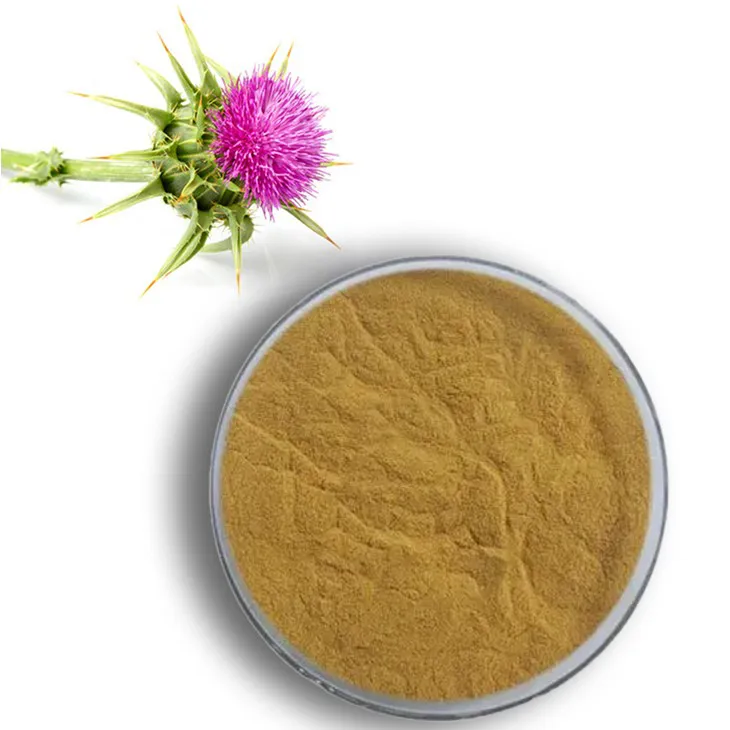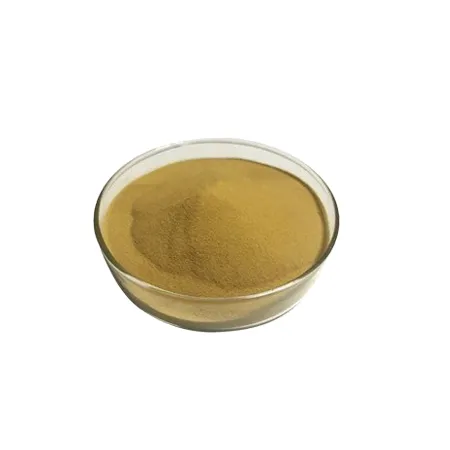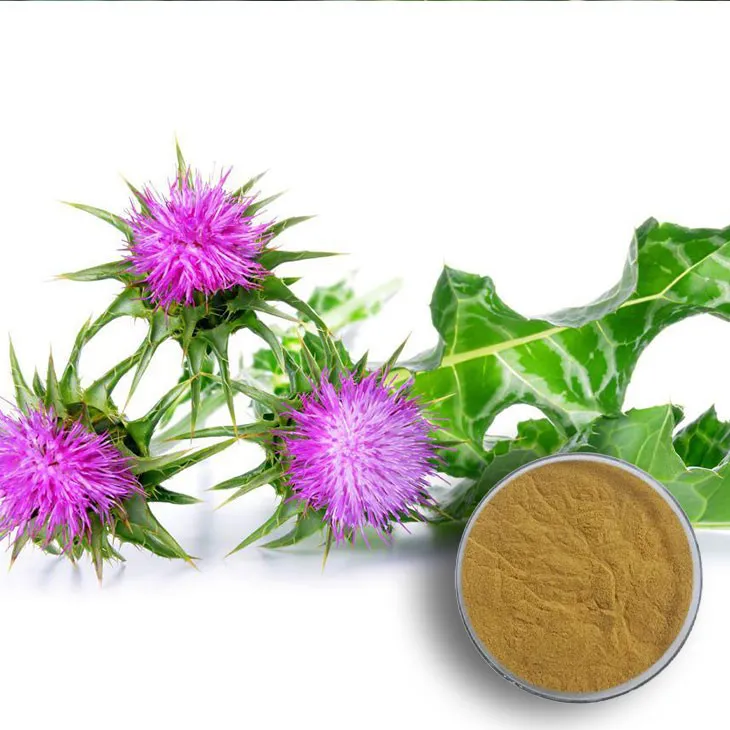- 0086-571-85302990
- sales@greenskybio.com
How to make powder from milk thistle extract?
2024-11-28

1. Introduction to Milk Thistle Extract
Milk Thistle Extract is derived from the milk thistle plant, which has been used for centuries in traditional medicine. It is known for its rich content of active ingredients, particularly silymarin. Silymarin is a complex of flavonolignans that possess antioxidant, anti - inflammatory, and hepatoprotective properties. Due to these beneficial properties, Milk Thistle Extract has gained popularity in the health and wellness industry, and converting it into powder form can enhance its usability in various applications such as dietary supplements, pharmaceuticals, and cosmetics.

2. Selection of Milk Thistle
2.1 Quality Criteria
The first step in making powder from milk thistle extract is to select high - quality milk thistle. The quality of the raw material significantly impacts the final product. Look for milk thistle with the following characteristics:
- Freshness: The plant should be harvested at the appropriate time. Harvesting too early or too late may result in a lower concentration of active ingredients.
- Appearance: The milk thistle should have a healthy appearance, with no signs of disease, pests, or physical damage.
- Origin: Knowing the origin of the milk thistle can also be important. Some regions may produce milk thistle with higher quality due to favorable soil and climate conditions.
There are various sources for milk thistle. It can be sourced from wild - grown plants or from cultivated farms. Cultivated milk thistle has the advantage of being more consistent in quality and can be grown under controlled conditions to optimize the content of active ingredients. However, wild - harvested milk thistle may also be used, provided that it meets the necessary quality standards and is sustainably harvested.

3. Extraction Process
3.1 Solvent Selection
The extraction of milk thistle involves the use of solvents to isolate the active ingredients. Common solvents used include ethanol, methanol, and water. Ethanol is often preferred as it can effectively extract silymarin while also being relatively safe for subsequent processing. The choice of solvent depends on factors such as the solubility of the target compounds, cost, and safety considerations.
3.2 Temperature and Time ControlDuring the extraction process, careful control of temperature and time is crucial. Different temperatures and extraction times can affect the yield and quality of the extract. Generally, a moderate temperature range is used to avoid degradation of the active ingredients. For example, when using ethanol as a solvent, an extraction temperature of around 40 - 60°C may be suitable. The extraction time can vary from a few hours to several days, depending on the extraction method and the desired concentration of the extract.
3.3 Extraction MethodsThere are several extraction methods available, including:
- Maceration: This is a simple and traditional method. The milk thistle is soaked in the solvent for a period of time, allowing the solvent to penetrate the plant material and extract the active ingredients. However, this method can be time - consuming.
- Percolation: In this method, the solvent is continuously passed through the milk thistle material. It is a more efficient way of extraction compared to maceration and can result in a higher yield of the extract.
- Supercritical Fluid Extraction: This is a more advanced method that uses supercritical fluids, such as supercritical carbon dioxide. It has the advantage of being a clean and efficient extraction method, with the ability to selectively extract the desired compounds. However, it requires specialized equipment and is more expensive.

4. Filtration of the Extract
4.1 Importance of Filtration
Once the extract is obtained, it is necessary to filter it to remove impurities. These impurities can include plant debris, undissolved solids, and other contaminants. Filtration is essential to ensure the purity of the extract and to prevent any potential interference with subsequent processing steps or the final product quality.
4.2 Filtration MethodsThere are different filtration methods that can be used, depending on the nature of the extract and the level of purification required. Some common filtration methods include:
- Gravity Filtration: This is a simple method where the extract is poured through a filter medium, such as filter paper or a porous membrane, under the force of gravity. It is suitable for removing larger particles.
- Vacuum Filtration: In this method, a vacuum is applied to increase the rate of filtration. It is more efficient than gravity filtration and can be used for extracts with a higher viscosity or a larger amount of impurities.
- Membrane Filtration: This involves the use of a semi - permeable membrane with a specific pore size to separate the impurities from the extract. It can be used for fine filtration and can effectively remove smaller particles and even some dissolved impurities.
5. Concentration of the Extract
5.1 Reasons for Concentration
After filtration, the extract may need to be concentrated. Concentration is necessary to increase the content of the active ingredients in the extract and to reduce the volume of the liquid, making it more suitable for the drying stage. A more concentrated extract also allows for a more efficient conversion into powder form.
5.2 Concentration MethodsThere are several methods for concentrating the extract:
- Evaporation: This is a common method where the solvent is evaporated using heat or under reduced pressure. Rotary evaporators are often used in laboratories for this purpose. The extract is placed in a flask and the solvent is evaporated, leaving behind a more concentrated extract.
- Reverse Osmosis: This method uses a semi - permeable membrane to separate the solvent from the solutes. Pressure is applied to force the solvent through the membrane, leaving a concentrated extract on the other side. Reverse osmosis is a more energy - efficient method compared to evaporation in some cases.
6. Drying of the Concentrated Extract
6.1 Importance of Drying
Drying is the final step in converting the milk thistle extract into powder. It removes the remaining solvent and moisture from the concentrated extract, resulting in a dry powder form. A dry powder is more stable, easier to store, and more convenient for transportation and further processing.
6.2 Drying MethodsThere are different drying methods available, each with its own advantages:
- Spray Drying: This is a widely used method in the food and pharmaceutical industries. In spray drying, the concentrated extract is sprayed into a hot drying chamber as fine droplets. The hot air in the chamber quickly evaporates the solvent and moisture from the droplets, forming a powder. Spray drying can produce a fine - particle - sized powder with good flowability and solubility.
- Freeze Drying: Also known as lyophilization, freeze drying involves freezing the concentrated extract first and then subjecting it to a vacuum to remove the ice (sublimation). Freeze - dried milk thistle extract powder retains more of its original structure and bioactivity compared to other drying methods. However, it is a more expensive and time - consuming process.
- Tray Drying: In tray drying, the concentrated extract is spread evenly on trays and placed in a drying oven. Hot air is circulated around the trays to dry the extract. Tray drying is a simple and cost - effective method, but it may result in a less uniform powder compared to spray drying or freeze drying.
7. Quality Control and Testing
7.1 Quality Control During Processing
Throughout the process of making powder from milk thistle extract, quality control is essential. This includes monitoring the quality of the raw milk thistle, the extraction process, filtration, concentration, and drying. Samples should be taken at various stages and tested for parameters such as the content of active ingredients, purity, and moisture content.
7.2 Final Product TestingOnce the powder is obtained, comprehensive testing should be carried out on the final product. This may include:
- Analysis of silymarin content: Using techniques such as high - performance liquid chromatography (HPLC) to determine the exact concentration of silymarin in the powder.
- Microbial testing: To ensure that the powder is free from harmful microorganisms such as bacteria, fungi, and yeasts.
- Heavy metal testing: To check for the presence of heavy metals such as lead, mercury, and cadmium, which may be present in the raw material or introduced during processing.
8. Packaging and Storage
8.1 Packaging
After the powder has passed all quality tests, it needs to be packaged properly. The packaging should protect the powder from moisture, light, and air, which can degrade the quality of the milk thistle extract powder. Common packaging materials include:
- Aluminum - foil pouches: These are often used for small - scale packaging. They provide an excellent barrier against moisture, light, and air.
- Plastic containers: For larger quantities, plastic containers can be used. They should be made of high - quality, opaque plastic to protect the powder from light.
The packaged milk thistle extract powder should be stored in a cool, dry, and dark place. The ideal storage temperature is usually between 2 - 8°C. Proper storage conditions can help to maintain the stability and shelf - life of the powder, ensuring that it retains its beneficial properties over time.
FAQ:
1. What are the main active ingredients in milk thistle extract?
Milk thistle extract is mainly rich in silymarin. Silymarin is a complex of flavonolignans which includes silybin, isosilybin, silychristin and silydianin. These components are known for their antioxidant, anti - inflammatory and hepatoprotective properties.
2. How do you ensure the quality of the selected milk thistle?
To ensure the quality of the selected milk thistle, one should look for plants that are free from pesticides, herbicides and other contaminants. It is also important to choose milk thistle that is grown in suitable environmental conditions. The maturity of the plant at the time of harvest also affects the quality. Usually, milk thistle should be harvested when the seeds are fully developed but not yet starting to scatter.
3. What factors need to be considered during the extraction process?
During the extraction process, temperature and time are crucial factors. The extraction temperature needs to be carefully controlled to ensure that the active ingredients are not degraded. Too high a temperature may damage the beneficial compounds. Also, the extraction time should be optimized. If the extraction time is too short, not all of the active ingredients may be extracted, while if it is too long, it may lead to the extraction of unwanted substances or degradation of the desired components.
4. Why is filtering necessary after extraction?
Filtering is necessary after extraction to remove impurities. These impurities may include plant debris, insoluble substances and other contaminants that were present in the original milk thistle or were generated during the extraction process. Removing these impurities ensures that the final powder product is pure and of high quality, and also helps to prevent potential interference with the activity of the active ingredients.
5. What are the different drying techniques that can be used?
There are several drying techniques that can be used. One common method is spray drying. In spray drying, the concentrated extract is sprayed into a hot drying chamber, where the liquid evaporates quickly, leaving behind a powder. Another technique is freeze - drying. Freeze - drying involves freezing the extract first and then removing the water by sublimation under low pressure. Each technique has its own advantages. Spray drying is relatively fast and cost - effective for large - scale production, while freeze - drying can better preserve the bioactivity of the active ingredients.
Related literature
- Milk Thistle Extract: Properties, Applications and Processing"
- "The Science behind Milk Thistle and its Extract: A Comprehensive Review"
- "Processing of Milk Thistle for Optimal Extraction and Powder Formation"
- ▶ Hesperidin
- ▶ citrus bioflavonoids
- ▶ plant extract
- ▶ lycopene
- ▶ Diosmin
- ▶ Grape seed extract
- ▶ Sea buckthorn Juice Powder
- ▶ Beetroot powder
- ▶ Hops Extract
- ▶ Artichoke Extract
- ▶ Reishi mushroom extract
- ▶ Astaxanthin
- ▶ Green Tea Extract
- ▶ Curcumin Extract
- ▶ Horse Chestnut Extract
- ▶ Other Problems
- ▶ Boswellia Serrata Extract
- ▶ Resveratrol Extract
- ▶ Marigold Extract
- ▶ Grape Leaf Extract
- ▶ blog3
- ▶ blog4
-
Chinese Oyster Peptide Manufacturers.
2024-11-28
-
The best organic Agaricus blazei extract.
2024-11-28
-
The best organic sugarcane extract.
2024-11-28
-
The best organic cocoa extract.
2024-11-28
-
Golden Seal Extract
2024-11-28
-
Konjac Powder
2024-11-28
-
Yellow Pine Extract
2024-11-28
-
Tongkat Ali Extract
2024-11-28
-
Black Rice Extract
2024-11-28
-
Berberis aristata Extract
2024-11-28
-
Marigold Extract
2024-11-28
-
Rose Hip Extract
2024-11-28
-
Jujube Extract
2024-11-28
-
Aminolevulinic acid
2024-11-28





















